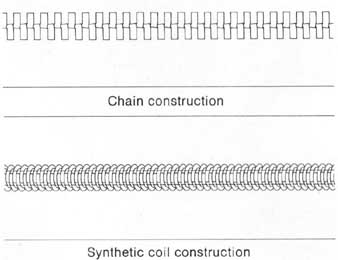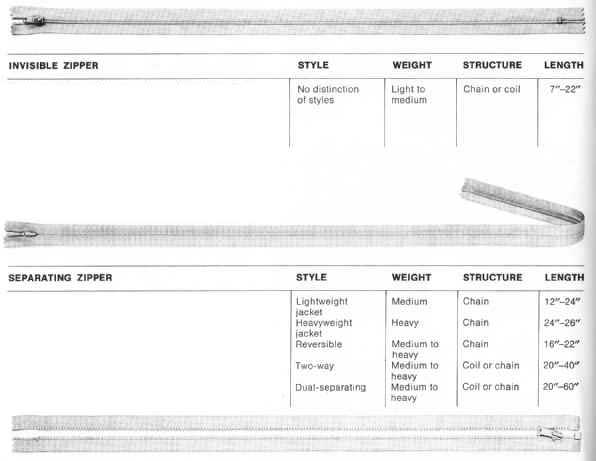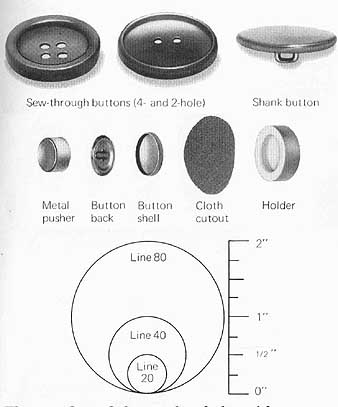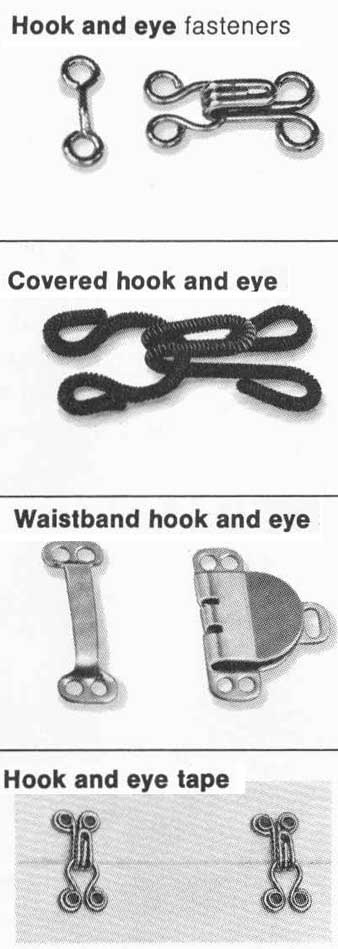Zippers
At first glance, zipper variety seems so great as to make selection difficult. Actually, it is narrowed down considerably by the very first step, the choice of style-the situation, location, type of opening, etc., for which the zipper is named. Another consideration is how conspicuous the zip per should be for the garment design. Zippers are made in three basic types, conventional, invisible, and separating; along with an illustration of each, the chart gives a description of styles within each group. Whatever zipper is selected, its weight should be compatible with that of the garment fabric. A zipper's weight is determined by its tape and structure (whether coil or chain). A coil is a continuous synthetic strand (nylon or polyester) twisted into a spiral and attached to a woven or knit synthetic tape. A chain consists of individual teeth, usually metal, attached to a cotton or cotton-blend tape. A coil, being lightweight and flexible, is ideal for light- to medium-weight fabrics. Although chains come in lightweight form too, they are slightly more rigid, which can cause buck ling on a lightweight fabric, and thus are best used on medium to heavy fabrics. Zipper length is specified on the pattern envelope. Buy this length unless experience has shown the recommended lengths to be either too long or too short, in which case select the next appropriate length.

- Chain construction; Synthetic coil construction
---
CONVENTIONAL ZIPPER

Conventional zippers, whether made with exposed teeth (chain) or coil, open at the top and are held together at the bottom. They come in more different styles than any other zipper type, each named for its most logical use. Some can be interchanged, however, if necessary. A neckline zipper, for example, can be shortened (see Zippers) and used as a skirt zipper. Size ranges given represent the overall output of all major manufacturers, and can vary within any single brand. Also, size increases do not necessarily come in 1" increments; some styles increase in increments of 2" or more. Depending on garment design, application may be by the centered, lapped, exposed, or fly method (see Zippers).
STYLE: Neckline Skirt Dress Trouser Blue Jean Decorative Upholstery
WEIGHT: Very light to medium; Very light to medium; Very light to medium; Medium to heavy; Heavy: Heavy; Heavy
STRUCTURE
Coil or chain; Chain
LENGTH
4"-36" 6 12"-14" 6" 5"-22" 24"-36"
---
INVISIBLE ZIPPER:
Invisible zippers are the newest type of zipper. As the name implies, they are structured differently from other zippers and are applied in a special way so that they disappear into a seam. When properly applied, neither the stitching nor the zipper teeth or coil is visible on the outside of the garment. Invisible zippers are used principally in skirts and dresses but they can go, in general, wherever a conventional zipper might be used, except in a trouser placket. Some manufacturers sell special zipper feet designed for application of their products. Some invisible zipper sizes are aggregates: e.g., 7"-9" is one size.
STYLE:
No distinction of styles
WEIGHT:
Light to medium
STRUCTURE:
Chain or coil
LENGTH: 7"-22"
-- SEPARATING ZIPPER
Separating zippers are made to open at both top and bottom, permitting the zipper opening to separate completely. Although used mainly on jackets, they can really be applied to any garment with a completely opened front. It is possible also to get reversible separating zippers with pull tabs on both sides. Also, dual reversible and two-way zippers that zip from the top and from the bottom are available for jumpsuits and similar garments. A centered application is the method generally used.
STYLE:
Lightweight jacket Heavyweight jacket Reversible Two-way Dual-separating
WEIGHT:
Medium Heavy Medium to heavy Medium to heavy Medium to heavy
STRUCTURE: Chain; Coil or chain
LENGTH: 12"-24" 24"-26" 16"-22" 20"-40" 20"-60"
Buttons:
Shank button Sew-through buttons (4 and 2 hole)
Metal pusher
Button back
Button shell
Cloth cutout
Holder
Button buying involves both decorative and practical considerations. One overriding practical qualification: whether a button is washable or dry Ieanab1e. Buttons must be compatible with a garment's care requirements. Though made in many shapes and materials, buttons are basically of two types-shank and sew-through. The shank button has a solid top, with a shank beneath to accommodate thicker fabrics and keep the button from pressing too hard against the buttonhole. Covered shank buttons can be purchased within limits, but can be made to suit almost any need with do-it-yourself kits like the one shown here.

The sew-through button has holes, either two or four, through which the button is sewed. A thread shank can be added if necessary (see Fasteners). Buttons come from as small as ¼ inch to 2 inches or more in diameter, with most size increments in eighths of an inch. Size is based on a system of lines, equivalents for which are shown here.
Snaps:
Snaps are two-part (socket and ball) fasteners with limited holding power.
Sizes range from fine (4/0) to heavy (4) in nickel or black-enamel finish and clear nylon,
Covered snaps are fabric covered regular snaps, made for use on garment areas where they will be seen. Sizes are mostly heavy (2-4), the colors generally neutral.

No-sew snaps are socket and ball fasteners that are not sewed to the garment but held in place by pronged rings. Holding power is good. Available in mostly heavy sizes, regular or no-sew snaps Snap tape comes with attached to cotton or tricot tape. Permits multiple snap application at one time. Sold by the yard or in precut lengths.
Hooks and eyes:
Hook and eye fasteners come with either straight eyes for lapped edges or loop eyes for meeting edges. Sizes from fine (0) to heavy (3) in nickel or black-enamel finish.
Covered hook and eye sets are usually large and suitable for coats, jackets, or garments made of deep pile fabric. Eyes are of the loop variety. Colors are mainly neutral.
Waistband hook and eye sets are extra sturdy, ideal for waistbands on skirts or pants. Special design keeps hook from slipping off the straight eye. Available in nickel or black finish.

Hook and eye tape comes with medium hooks and loop eyes attached to cotton tape. Permits multiple hook and eye application at one time. Sold in neutral colors by the yard.

Eyelets:
Eyelets are round metal reinforcements for holes that are made in belts and laced closures. They are easily applied with a special pliers, illustrated here (some pliers come with an interchangeable head that permits use also to attach no-sew snaps). Sold in packaged units; eyelets are available in nickel- and gilt-finish aluminum and enameled brass. Some times packaged with special pliers.
Nylon tape Nylon tape fastener is composed of two tape strips, one with a looped nap surface and the other with a hooked nap. When pressed together, surfaces grip and remain locked until pulled apart. Useful on garment details, such as cuffs and detachable trims; a good substitute for other closures in home decorating, as with upholstery. Tape comes in sew-on, iron-on, and stick-on forms.
